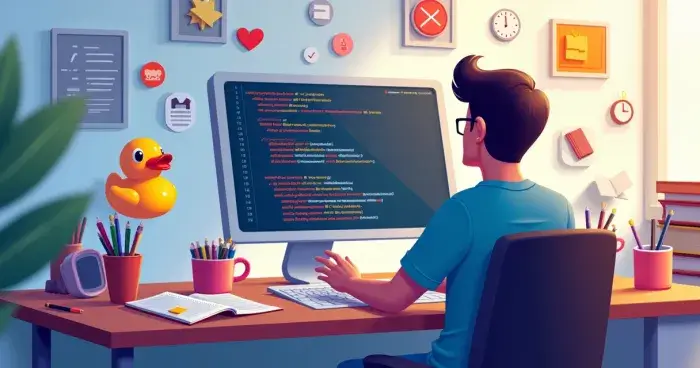The Debugging Diaries of Developers
There is a silence that only developers know. It’s the quiet that follows a failed software build at midnight. That uncomfortable hush after hitting “Run” and seeing everything go wrong—again. It never quite feels the same, not twice, not for any two developers. Debugging is less of a science than some want to believe. Perhaps it’s closer to hunting for ghosts with a lamp that only flickers when you turn your back.
This, then, is a look inside real debugging stories, strange habits, hard-earned lessons, and the odd joy of finding that missing semicolon.
Why debugging never feels routine
In theory, debugging is just the process of finding and fixing errors in code. In reality? It’s a maze with hallways that rearrange themselves.
Debugging can turn a five-minute fix into an all-night marathon.
Developers talk to their screens. Some plead. Others bargain. And a few, only half-joking, ask their rubber duck for help. Each person’s method forms a sort of diary—they whisper their troubles to their tools and hope for a reply.
The types of bugs developers meet
Not all bugs are equal. Some you spot right away, others hide so well you’d swear the program is mocking you.
- The “typo” bug: Maybe just a missing letter, an extra parenthesis, or the careless swap of a variable. Quick to find, a relief to fix.
- The “it works on my machine” bug: Local tests pass. Colleagues report chaos. The difference is invisible at first. Hours go by.
- The “timing” bug: Sometimes called a race condition. The code runs differently on each try. Pinning it down feels like chasing smoke.
- The “impossible” bug: Every developer’s favorite. You’re sure it can’t happen, until you see it. And then you double-check your coffee.
- The “environment” bug: An issue only in staging, never in production, or maybe the reverse. Libraries, versions, hidden dependencies—it’s a puzzle with missing pieces.
I remember my own time stuck on a bug that seemed to vanish every time I added a line of code to debug it. Then it would return as soon as I removed that line. A real-life hacker might have spent less time with my project. Looking back, I realize how much I learned from that one problem. Yet, it felt like a waste in the moment.
The rituals developers keep

The debugging process is rarely just technical; it’s oddly personal. Habits form, rules are made and broken, superstitions take hold.
- Rubber duck debugging: Many developers talk problems out to an inanimate object. Saying the issue aloud—sometimes to an actual rubber duck—can make the answer suddenly obvious.
- Stepping away: Sometimes the only fix is a walk, a shower, or even sleep. Fresh eyes have solved more bugs than any programming textbook.
- Scatter-debugging: Dropping print statements or breakpoints everywhere. Some people feel guilty about this mess; others wear it as a badge.
- Blame the compiler or the environment: Occasionally, developers convince themselves the tools are at fault. Rarely true, except on the rare day it actually is.
Sometimes, the bug was you all along.
Tools that both help and hinder
Of course, there are many tools supposed to make this journey easier. Debuggers, profilers, static analyzers, and endless log files. Each has its strengths and quirks. But it’s easy to end up lost in the details—following traces through code until they’re loops with no exit.
It’s a strange truth: sometimes a tool helps just by making you slow down long enough to see the problem. Not every developer trusts these tools at first. There’s a moment where you wonder if you’re using them incorrectly, or if they’re showing you exactly what you refuse to see. It can be hard to admit.
The emotional rollercoaster
Debugging isn’t just technical work; emotion weaves through every hour spent chasing an error.
- Frustration: The program fails. Again. Logic says the fix should just work. It doesn’t. Confidence wavers.
- Hope: You see a hint. The error seems clearer. There’s hope—then, after all the effort, another dead end.
- Relief: The moment the cause is found. The answer feels obvious, even if it was invisible for hours. You want to laugh and sigh at once.
- Second-guessing: The bug is gone, but doubts linger. Is it fixed everywhere? For everyone? Or will it sneak back tonight?
All of it makes finding and fixing bugs oddly addictive. The promise of that “aha” moment, short-lived as it may be, keeps people coming back.
Lessons that stick
It’s strange, but the bugs that took the longest to fix are usually the ones you can’t forget. Those stories become warnings to share or quiet jokes among friends.
Next time, you might spot the problem twice as fast.
- Keep notes: Writing down details—what failed and why—can save time later. Memory fades fast, and bugs like to repeat themselves.
- Don’t ignore warnings: Compilers and editors complain for a reason. It’s tempting to dismiss every message as noise. But the one you skip might matter most.
- Ask for help: Even brief conversations with teammates—or with yourself, out loud—can turn confusion into clarity.
- Assume nothing: Familiar code hides new bugs. Every fix needs a little doubt, a willingness to believe you might be wrong.
The human side: stories from the trenches

Many developers remember one bug that changed them. Sometimes, it’s as simple as a forgotten semicolon. Sometimes, months are spent chasing a single line that’s out of place. Looking back, these memories blur together—late-night pizza, mountains of error logs, half-finished thoughts scribbled on sticky notes.
One team spent an entire week convinced their backend code was broken, only to find the true culprit was a network firewall. Another time, a junior developer fixed an issue just by asking why a function existed in the first place. No grand solution—just curiosity and luck.
Not every bug gets a big finish. Some just fade. Days blend. The mistakes inform future habits, if not always the immediate next project.
Why we keep debugging
Debugging is never perfect. Even the best developers find the same problems, fall into old habits, and are humbled by software that refuses to behave. Tools change. Languages change. But the strange pleasure of finding the answer never really fades, even after years.
The meaningful part is not just the fix, but what you learn—about code, and sometimes even about yourself.
If you talk to enough developers, you’ll hear it: They secretly love the puzzle. The frustration and repetition, the late nights, the odd routines. Debugging is how they really get to know their code. Each error a diary entry. Every solution, a little victory.
And maybe, that’s why the next time the silence falls after a failed build, someone will still whisper, “I’ll just try one more thing.”
